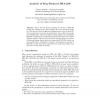Free Online Productivity Tools
i2Speak
i2Symbol
i2OCR
iTex2Img
iWeb2Print
iWeb2Shot
i2Type
iPdf2Split
iPdf2Merge
i2Bopomofo
i2Arabic
i2Style
i2Image
i2PDF
iLatex2Rtf
Sci2ools
FSE
2006
Springer
2006
Springer
Analysis of Step-Reduced SHA-256
This is the first article analyzing the security of SHA-256 against fast collision search which considers the recent attacks by Wang et al. We show the limits of applying techniques known so far to SHA-256. Next we introduce a new type of perturbation vector which circumvents the identified limits. This new technique is then applied to the unmodified SHA-256. Exploiting the combination of Boolean functions and modular addition together with the newly developed technique allows us to derive collision-producing characteristics for step-reduced SHA-256, which was not possible before. Although our results do not threaten the security of SHA-256, we show that the low probability of a single local collision may give rise to a false sense of security.
| Added | 23 Aug 2010 |
| Updated | 23 Aug 2010 |
| Type | Conference |
| Year | 2006 |
| Where | FSE |
| Authors | Florian Mendel, Norbert Pramstaller, Christian Rechberger, Vincent Rijmen |
Comments (0)

